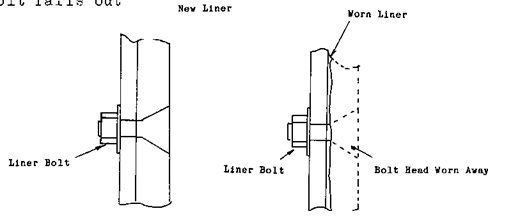More than the normal hot bearings and gear reducers, worn chains, oil levels, and the other common problems that are familiar with moving machinery, is the problems with the high abrasion caused by the ore movement. This is where the bolts on the liners become a problem indicator. There is only two ways that a bolt may fall out, one if the nut comes off or two if the head is worn away and the bolt falls out.
If one of the bolts has disappeared it is a very good idea to check the liner that the bolt was holding in. The chances are that it is very worn and ready to fall off too. If the liner does fall, there is an excellent possibility that it will get caught in some of the equipment further along in the process either doing some damage or causing down time for the circuit. If the liner is missing and can’t be found it should be reported to your supervisor. He will alert the operators farther along in the process to watch for it.
As you give the equipment its mechanical once over you will watch for other problems that may slow production or cause extra work. This will be primarily in the form of obstructions. It could be wood or steel beginning to block the entrances and exits of these feeders, or a buildup of fine and/or frozen material that may be lodged inside the feeder restricting the flow of ore. This will lower the amount of ore that can go through the feeder at any one time.
A good operator is always aware of his safety, so as you walk your circuit checking it, be aware of anything that might be painful. Oil spills cleaned up, pry bars and other equipment should be stored properly. Anything that may be a tripping or slipping hazard fixed. All of the safety equipment that is in your area should be in good shape, things like the guards over moving equipment should be tight and in place, and fire extinguishers filled. Mines can be dangerous enough without adding to the danger by neglecting what is there for your protection.

